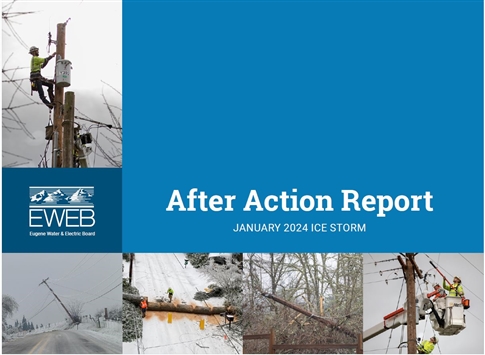Related News
Related News
-
Energy shortfall of 9 gigawatts projected for the Northwest
By 2030, a dry year combined with soaring energy demand during extended cold snaps could lead to rolling blackouts, a new study warns.
Find Out More -
Sustainability Snapshot - Celebrating Energy Efficiency Projects in the Community
Sustainability Snapshops highlight impactful projects completed by EWEB's Customer Solutions department, as a way to celebrate the meaningful work happening behind the scenes.
Find Out More -
McKenzie Valley electric service territory realignment study reaches key milestone
EWEB Commissioners approved a resolution authorizing the General Manager to negotiate and execute agreements with Lane Electric Cooperative regarding a potential realignment of electric service territory in the McKenzie Valley at the Board’s December meeting.
Find Out More -
EWEB secures $2.5 billion of reliable, affordable, carbon-free energy for customers
The new contract with EWEB’s largest energy supplier, the Bonneville Power Administration, forms the foundation of a diverse energy portfolio.
Find Out More -
Women in STEM: Meet the Hydro Project Engineer Building Habitat for Salmon
EWEB Engineer Associate Val Chang found her way to the McKenzie River from Los Angeles, inspired by heritage trips to the waters of Taiwan and key mentors along the way.
Find Out More -
Public Power Week Poster Contest Winners 2025
The results are in! View the winning posters from EWEB's 2025 Public Power Week Poster Contest.
Find Out More -
EWEB Hometown Heroes compete internationally
Out of 290 teams from 14 different countries, EWEB's Lineman Rodeo team places in the top third of competitors.
Find Out More -
EWEB's Halloween Truck-or-Treat is a huge success
Community members are accustomed to spotting EWEB trucks around Eugene streets and neighborhoods. But last week, those familiar vehicles looked a little different. At EWEB's second annual Truck-or-Treat Customer and Crew Appreciation Event, our fleet transformed into a festive Halloween spectacle.
Find Out More -
Let's Talk Turkey. Is your family ready for winter?
We're heading into the holidays, but that also means snow, ice, and not-so-nice weather might be in the forecast. Here are some tips to prepare in advance.
Find Out More -
Vote for your favorite Public Power Week Posters
The top five submittals will receive awards. Help us pick the winners.
Find Out More -
EWEB Hosts Annual Spill Drill to Protect McKenzie River
EWEB led emergency responders in its annual “spill drill” on the McKenzie River on Wednesday, Oct. 15, at the Trail Bridge Campground.
Find Out More -
EWEB Partners with Eugene School District 4J to Celebrate New Kennedy Middle School Emergency Water Station Site
Hundreds of attendees practiced filling up water containers at Saturday's demonstration event.
Find Out More -
Electric Projects underway in North & South Eugene
Underground lines and disaster-resilient power poles are part of EWEB’s infrastructure upgrade near Eugene’s largest natural resource area.
Find Out More -
EWEB general manager to retire in 2026
EWEB launches nationwide search for next leader to continue the progress of the last decade and ensure a smooth transition.
Find Out More -
The Bonneville Power Administration Rate Change and Your EWEB Bill
BPA’s finalized rate increase is smaller than projected, and EWEB’s pass-through adjustment effective October 1, 2025 will now be 2.7% for residential customers—down from the anticipated 4%.
Find Out More - Show More
The Big Freeze 2024: After Action Report
April 16, 2024 • Robyn Smith, EWEB Communications

Winter 2024 was one for the records books, and we'll look back on it for years to come and say, "That was a doozy!"
The back-to-back January Ice Storms caused widespread damage to EWEB’s service territory, affecting approximately 38,000 customers. Preliminary repair costs were over $8 million, and additional repairs to transmission lines are still required.
The Ice Storm After-Action Report presented during the April board meeting (Starting at 03:22:00) highlights lessons learned and the overall priorities (below) for improving EWEB's storm response.

Per Incident Command System (ICS) and FEMA best practices, a valuable part of the closeout process for major incidents is to discuss lessons learned with all staff involved and document things that went well and those that need improvement. These findings drive and ultimately create an action plan to recognize strengths and areas for improvement, such as processes, training, and resource needs before the next event occurs. This is completed through a series of “Hot Washes.”
"A hot wash is a chance for each incident response section to huddle with their teams and discuss what worked well and what didn't, and then we come together with a long list of lessons learned," said Tyler Nice, electric operations manager. "While each section has action items to work on individually, the overall priorities were boiled down based on feedback from all the sections. Some ideas are quick tasks while others will need to be cross-functional initiatives that are worked out over the course of this year."
The resulting After-Action Report is an overall summary of the event, pertinent data, and action items.
EWEB will focus on the following overall priorities:
Areas to emphasize:
- Annual ICS role-specific training in processes and systems used in storm response
- Pre-storm season stock up on parts, materials, and equipment
- Policy-driven support and resource allocation for ICS training and event response continuous improvement efforts
Opportunities for improvement:
- Increase (and train) ICS organizational resources for better management of events be all business units
- Update and refine the Assessment & Restoration process, including Estimated Time of Restoration data capture and use for planning and outage map accuracy & efficiency
- Practice discipline in using ICS forms and structure to better manage the event and report to FEMA
Jeannine Parisi, resiliency and emergency program manager, says, "We see major disruptive events happening more frequently. We can use learnings from this event to refine EWEB’s planning efforts and response so we can get back to regular business more quickly. Lessons learned from this event will help us become more resilient together. "
Progress on the top-level action items will be tracked and reported during EWEB’s quarterly ICS team meetings.
"With the ice remaining only in memory and the bulk of restorations behind us, we now focus on the cleanup and improvement process," said Nice. "I am so proud of our team’s response and even more appreciative of the community's support through this devastating incident.”
What is ICS?
For context, the Incident Command System (ICS) is a standardized approach to incident management used by government agencies at all levels. Roles and teams are established for safety, planning, operations, logistics, interagency coordination, and public communication. Each team works simultaneously to coordinate and resolve issues that arise during emergency response. EWEB activates ICS to prepare for and respond to major events.

